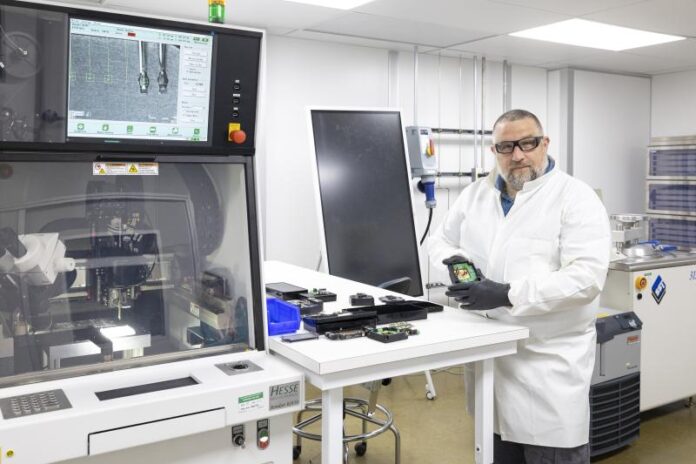The U.S. electric grid is more than just power plants and transmission lines — it’s a web of connections among millions of small components, working together to allow you to flick on the lights when you walk in the door. That mechanical switch is only the last of many between the power plant and your home.
Researchers at the Department of Energy’s Oak Ridge National Laboratory are supporting the grid by improving its smallest building blocks: power modules that act as digital switches. That starts with tiny, semiconducting chips to construct faster, safer and more efficient power modules from scratch. “We’re going from the smallest semiconductor device all the way to the converter and application testing,” said ORNL researcher Brian Rowden.
Power modules manage grid equipment like converters and inverters, which regulate the type and flow of electrical current. Inverters are particularly vital to the U.S. clean energy transition because they connect the grid to electric vehicle chargers, wind and solar power.
The lab constructs modules, housed in an oblong case the size of a person’s hand, that control power moving through a system. ORNL engineers can rapidly move these components from development to evaluation because Rowden’s lab is co-located with low- and medium-voltage test beds in ORNL’s Grid Research Integration and Deployment Center, or GRID-C.
“We’re equipped to design, reliably build and test new power module technologies,” Rowden said. “We’re making the things we can’t buy. Most of the work is creating building blocks with sensing, controls and feedback for grid hardware research, to manage everything from microgrids to substations.”
ORNL is taking on the challenge of replacing mechanical switches, which are still prevalent in medium- and high-voltage power electronics. A digital switch moves power faster and with less loss than a mechanical switch. It also increases safety because it can shut off in less than a millisecond.
Most medium-voltage power modules use silicon chips, but Rowden is testing silicon carbide, which can switch faster with less power loss. Another advantage of silicon carbide modules is that magnetic components and capacitors can be smaller while providing the same power. ORNL is also geared to test new materials for the power module components such as substrates and baseplates, including printable polymers and ceramics.
Packaging innovations could provide more fail-safe design and reduce resistance, allowing more power to flow through the module. These changes can be tested faster by using the lab’s cutting-edge equipment to rapidly construct delicate parts that would otherwise be built by hand. For example, a programmable wire bonder automates the custom attachment of tiny wires within a module, while an ultrasonic welder increases the module’s reliability and electrical performance.
Rowden supplies power electronics building blocks not only to colleagues studying the grid, but to electric vehicle researchers at DOE’s National Transportation Research Center next door. Power modules are used in the drivetrain of an electric motor, the converter to charge an EV battery and the stationary battery charging infrastructure. But Rowden is also pursuing electronics development for EV aircraft and drones, as well as for extreme environments with high levels of radiation, vibration or temperature.
UT-Battelle manages ORNL for the Department of Energy’s Office of Science, the single largest supporter of basic research in the physical sciences in the United States. The Office of Science is working to address some of the most pressing challenges of our time. For more information, please visit energy.gov/science.








